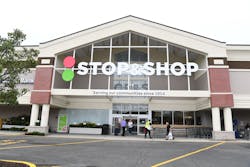Stop & Shop, a major retail chain in the US Northeast, announced today that it will install microgrids in 40 of its grocery stores in Massachusetts and New York. The microgrids will use Bloom Energy fuel cells.
The combined electric capacity of the 40 microgrids is 10 MW.
The microgrids, which run 24/7, will ensure that power flows to the stores even if the electric grid is experiencing an outage. Hurricanes in the Northeast at times have knocked out power for as long as two weeks. Grocery stores become critical for communities during such natural disasters.
“Our stores are an important community resource for our customers, particularly when severe weather strikes,” said Gordon Reid, president of Stop & Shop, which has 60,000 employees at 400 stores in Massachusetts, Connecticut, Rhode Island, New York and New Jersey. “Whether customers need to stock up on food, batteries, flashlights, other emergency items, or even their prescription medications, we know how vital the products and services our stores provide are.”
Stop & Shop will begin installation of the microgrids early this year on Cape Cod, Massachusetts, followed by additional stores in Massachusetts and Long Island. A collaboration of sponsors are working with Bloom Energy and Stop & Shop on the microgrids, including the two local utilities, Eversource and National Grid; a community choice aggregation, the Cape Light Compact, and energy efficiency organization Mass Save.
The Stop & Shop microgrids are expected to reduce carbon emissions by over 15,000 metric tons per year, the equivalent of removing about 3,200 cars from the road.
Bloom Energy’s fuel cells convert natural gas or biogas fuel into electricity without combustion and use no water in normal operations. As a result, the grocery store chain expects to save more than 1.6 billion gallons annually. The fuel cells also create no smog-forming pollution and particulate emissions, according to Bloom Energy
Stop & Shop and Bloom Energy have worked together in the past. A store in Vernon, NY, has used Bloom’s technology since 2014. Bloom technology also is in use at a Stop & Shop store in Peekskill, NY.
Bloom fuel cells, ready for the Northeast’s winter. Photo courtesy of Bloom Energy
“Clean, reliable, resilient power is critical to keeping businesses and families working,” said KR Sridhar, founder, chairman and CEO of Bloom Energy. “We’re proud to give Stop & Shop customers the peace of mind that their local stores will remain open before, during and after severe storms or natural disasters that disrupt the electricity grid.”
Compared with manufacturing, industrials and other business sectors, retail stores have been relatively slow to adopt microgrids technology, although their numbers have begun to increase in recent years. A Whole Foods in Brooklyn was an early entrant into the space. In Texas, the H-E-B and Buc-ee’s store chains have installed microgrids in partnership with Enchanted Rock.
Track news about retail microgrids. Subsribe to the free Microgrid Knowledge newsletter.







